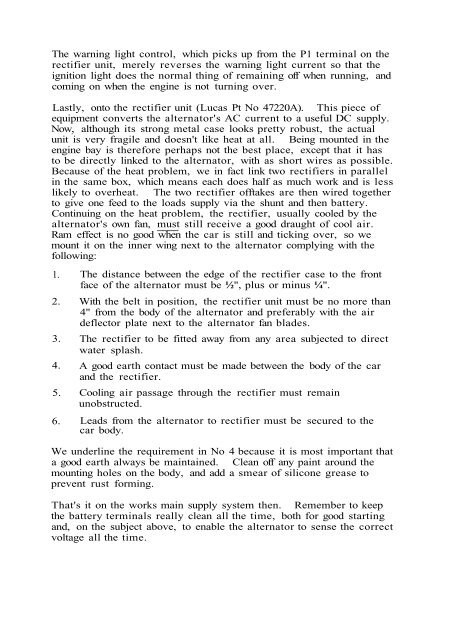¼ - Rasmotorsport.com
¼ - Rasmotorsport.com
¼ - Rasmotorsport.com
You also want an ePaper? Increase the reach of your titles
YUMPU automatically turns print PDFs into web optimized ePapers that Google loves.
The warning light control, which picks up from the P1 terminal on the<br />
rectifier unit, merely reverses the warning light current so that the<br />
ignition light does the normal thing of remaining off when running, and<br />
<strong>com</strong>ing on when the engine is not turning over.<br />
Lastly, onto the rectifier unit (Lucas Pt No 47220A). This piece of<br />
equipment converts the alternator's AC current to a useful DC supply.<br />
Now, although its strong metal case looks pretty robust, the actual<br />
unit is very fragile and doesn't like heat at all. Being mounted in the<br />
engine bay is therefore perhaps not the best place, except that it has<br />
to be directly linked to the alternator, with as short wires as possible.<br />
Because of the heat problem, we in fact link two rectifiers in parallel<br />
in the same box, which means each does half as much work and is less<br />
likely to overheat. The two rectifier offtakes are then wired together<br />
to give one feed to the loads supply via the shunt and then battery.<br />
Continuing on the heat problem, the rectifier, usually cooled by the<br />
alternator's own fan, must still receive a good draught of cool air.<br />
Ram effect is no good when the car is still and ticking over, so we<br />
mount it on the inner wing next to the alternator <strong>com</strong>plying with the<br />
following:<br />
1.<br />
2.<br />
3.<br />
4.<br />
5.<br />
The distance between the edge of the rectifier case to the front<br />
face of the alternator must be ½", plus or minus <strong>¼</strong>".<br />
With the belt in position, the rectifier unit must be no more than<br />
4" from the body of the alternator and preferably with the air<br />
deflector plate next to the alternator fan blades.<br />
The rectifier to be fitted away from any area subjected to direct<br />
water splash.<br />
A good earth contact must be made between the body of the car<br />
and the rectifier.<br />
Cooling air passage through the rectifier must remain<br />
unobstructed.<br />
6. Leads from the alternator to rectifier must be secured to the<br />
car body.<br />
We underline the requirement in No 4 because it is most important that<br />
a good earth always be maintained. Clean off any paint around the<br />
mounting holes on the body, and add a smear of silicone grease to<br />
prevent rust forming.<br />
That's it on the works main supply system then. Remember to keep<br />
the battery terminals really clean all the time, both for good starting<br />
and, on the subject above, to enable the alternator to sense the correct<br />
voltage all the time.


